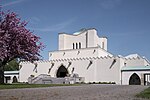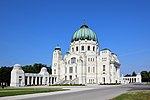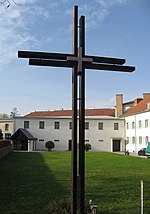Schloss Neugebäude

Neugebäude Palace (German: Schloss Neugebäude) is a large Mannerist castle complex in the Simmering district of Vienna, Austria. It was built from 1569 onwards, at the behest of the Habsburg Emperor Maximilian II. The site of the palace is said to be where the Ottoman Sultan Suleiman the Magnificent's tent was erected during the 1529 Siege of Vienna. The palace was apparently modeled after it.It fell into disuse already in the 17th century and today stands in ruins. Protected as a historical monument since the 1970s, there are various efforts to restore the site.In 1922, Clemens Holzmeister's architectural designs for Austria's first crematorium placed Feuerhalle Simmering into the walled gardens of the derelict Schloss Neugebäude, thus putting the former palace gardens with its many ancient trees (designated natural monuments) to new use as urn burial ground.
Excerpt from the Wikipedia article Schloss Neugebäude (License: CC BY-SA 3.0, Authors, Images).Schloss Neugebäude
Neugebäudestraße, Vienna KG Kaiserebersdorf (Simmering)
Geographical coordinates (GPS) Address External links Nearby Places Show on map
Geographical coordinates (GPS)
| Latitude | Longitude |
|---|---|
| N 48.160277777778 ° | E 16.443611111111 ° |
Address
Schloss Neugebäude
Neugebäudestraße
1110 Vienna, KG Kaiserebersdorf (Simmering)
Austria
Open on Google Maps










